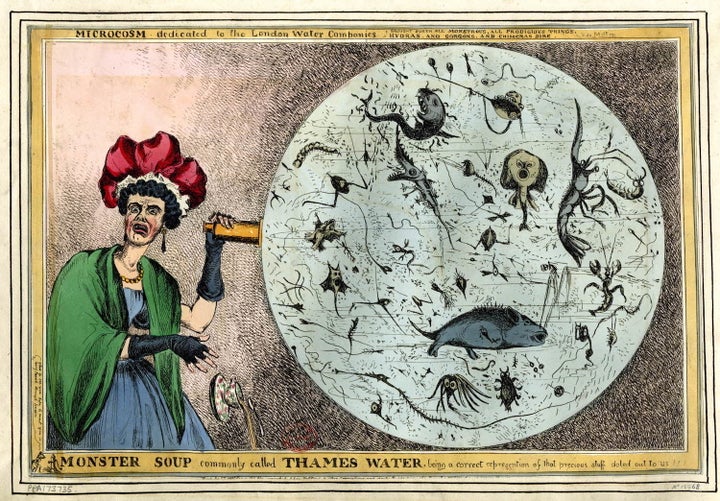By Nick Jeffries
This article originally appeared on Circulate, the online location for news and insight on the circular economy.
Cities are places of ingenuity and delight as well as engines of economic growth and opportunity. However, they are also great concentrators of organic material that is often landfilled at high cost or leaked into the environment, causing a host of environmental problems. This throughput is a missed opportunity: if cities could effectively recover and valorise their organic waste they could save costs, realise new revenue streams and regenerate natural capital in the process.
In 1858, the extreme summer heat in London cooked up the accumulated sewage in the Thames to such a degree that the smell caused Dickens to remark: “even a short whiff is of a most head-to-stomach distending nature”. The situation became so bad that Queen Victoria abandoned a pleasure cruise within minutes of leaving the shore, and the government considered relocating to Oxford. The ‘Great Stink’, referred to by one commentator as a “pestiferous and typhus breeding abomination”, was caused by the combined ablutions and industrial activities of 2.5 million citizens being allowed to flow unchecked into the city’s many waterways. Solutions were sought from the leading engineers and thinkers of the time and Sir Joseph Bazalgette famously won the day. In so doing, he entered the annals of London’s history: his design still forms the backbone of the city’s world famous sewage system.

A satirical interpretation of Thames pollution during the early 19th century.
What is less well known is that Justus von Liebig, a German chemist and contemporary of Bazalgette, tried to persuade British government officials to consider an alternative design. Rather than simply collecting sewage and disposing of it downstream of the Metropolitan area, he suggested a system that should return nutrients to the fields of Britain. Von Liebig had studied the efficiency with which Roman sewers transferred vast quantities of minerals from the farmland of the empire to the Mediterranean, correctly observing that the equilibrium of soil fertility is destroyed by the incessant removal of phosphates. No-one can doubt the benefits Bazalgette’s scheme brought to the improving of sanitary conditions in London. However, von Liebig was correct in recognising that a collection and disposal approach is the hallmark of a linear system, precipitating massive losses of beneficial nutrients from the earth’s soils.
This contrast between Bazalgette and von Liebig is more relevant than ever and prompts us to question a system that has worked for more a century and a half. Could the huge volumes of biological materials that flow through our cities be seen today as an opportunity? The organic waste fraction of municipal solid waste, and the wastewater that flows through sewage systems, are traditionally construed as liabilities, both in economic and environmental terms. This article explores the idea that designing effective recovery and processing systems can reverse the equation, turning organic waste into a source of value and contributing to the restoration of natural capital.
Urban Biocycles
The biocycle sector of the economy is associated with managing these biological materials at the production, processing, retail and after-use stages. It encompasses, for example, agriculture, forestry, fishing, food processing, textile manufacturing, biotechnology, and organic waste management. In total the sector contributes USD 12.5 trillion to the global economy every year.

Click to read the Ellen MacArthur Foundation’s new scoping paper on Urban Biocycles.
Throughout history humans have predominantly lived in villages, hamlets and farmsteads. However, relatively recently there has been a rapid demographic shift to dense urban living. In von Liebig’s time about 8% of people lived in cities, in 1950 it was 30%, and now more people live in cities than in the countryside. Providing food for all these people represents a massive challenge. Take London for example: it is estimated that its citizens need 30 million meals a day. Although there is a nascent shift to urban farming, most of this food still comes from the countryside.
The cultivation of food in rural farms to feed urban dwellers can be viewed as a linear process, in which nutrients are taken up by plant crops, pass through human digestive tracts, and often end up in landfill or the sea. This linear path leads to many negative impacts, including the degradation of soils, an overdependence on synthetic fertilisers, the creation of coastal dead zones, and the emission of high volumes of greenhouse gases. Food waste, equivalent to about 30% of all food produced, only amplifies these negative effects (to get an idea of its scale, in a list of countries with the highest greenhouse gas emissions global food waste would come third behind China and the US).
Where there’s muck, there’s brass
A circular economy, one that differentiates between technical and biological nutrients, aims to loop biological matter safely back to the soil, if possible via a series of value creating stages. These stages could include extraction of materials, fertilisers, energy, water and soil conditioners. The potential opportunity is highlighted in a recent study carried out by Circle Economy, which estimated that making use of the residual organic waste streams that flow through the City of Amsterdam could not only lead to material savings and reductions in carbon emissions, but also represents an economic opportunity worth EUR 150 million.
An emerging technology concept known as the ‘biorefinery’ could offer a way of recovering this value. Comparable in some respects to oil refineries, this emerging technology can accept a variety of different feedstocks and employ a number of techniques such as thermal treatment, biological processes and enzymatic conversions to transform organic materials into valuable chemicals and products. The Dutch company DSM provides an exciting example of the technology in action. In recent years DSM has developed a method to produce second generation bioethanol from residual agricultural feedstocks that crucially do not compete with food production, one of the common criticisms of biofuels. The breakthrough came through the isolation of enzymes in the dung of elephants, which derive a lot of their sustenance from plant matter nutritionally useless to humans.
A municipal Wastewater Treatment Plant (WWTP) could be viewed as a special type of biorefinery as it has the potential to convert sewage, an organic feedstock, into a variety of valuable products. The technologies that allow compost, energy and clean water to be derived from sewage are well-established. In recent years, laboratories and start-ups around the world have had some success in producing higher value products such as cellulosic materials, alginates, and platform chemicals such as succinic acid and PLA that can be used to produce bioplastics. Most of these chemicals are already produced commercially and at a large scale from standard feedstocks, so there are competition barriers that need to be overcome. However, these are exciting developments on the path to transforming WWTPs from expensive cost centres to profit-generating resource factories.

A circular economy for water – opportunity lying in wait? Read the full article here.
To highlight this potential, compare the energy required to treat wastewater with its embedded energy. The energy required to run the wastewater treatment processes of solid removal, biological digestion, disinfection and discharge is significant: in New York alone the daily energy bill can be up to US$ 250,000. However, the embedded energy (in the form of heat and chemical energy) in wastewater actually exceeds the energy required to treat it by a factor of 14. While much of this potential is in the form of low grade heat which is difficult to recover, theoretically at least a fifth of it could be converted to biogas and then to electricity, so it should be possible to create energy positive treatment plants. Indeed, in the city of Odense in Denmark, a utility called VCS has done just that. Their Ebjy Mølle plant harvests enough energy from the wastewater it treats to run the treatment process and has an extra 10% left over that it sells back to the grid.
When Mads Leth, the Director of Operations and Maintenance for VCS was asked what the most important factor was in making Ebjy Mølle energy positive, his reply was: “A change in mind-set is critical. The technology exists, but it must go hand in hand with a mind-set that says not only do we want to produce clean water, but we want to do it in a way that leads to carbon neutrality which goes hand in hand with energy optimisation.”
Designing for circularity from the start
There are reasons why this shift in mind-set could be of particular benefit to emerging economies such as India.
The sub-continent’s infrastructure often struggles to deal with the demands placed on it. In India’s cities less than a third of household wastewater is treated; the rest discharges into open drains or into the ground, eventually finding its way into aquifers and waterways, both sources of drinking water. The problem is compounded by the fact that for more than two-thirds of the time sewage treatment plants do not operate, mainly due to expensive or unreliable power supplies. This puts a huge strain on the national economy, the environment and public health: one estimate puts the cost at USD 54 billion.
One advantage though is that India is not yet locked into old, linear infrastructure. More than two-thirds of the buildings and infrastructure needed to serve the 450 million new city dwellers expected by 2050 have yet to be built. Imagine if all India’s new water treatment plants were designed like Odense’s, feeding energy into the grid rather than drawing energy from it. The technology exists; what is needed is a shift in mind-set leading to a new approach to designing future plants.
Returning to the Great Stink: what if the ‘opposing’ views of Bazalgette and von Liebig could be reconciled? If they were, future wastewater systems would be designed to recognise sewage, and other organic materials, not only as a public health hazard, but also as a source of valuable resources and an essential component of a virtuous nutrient cycle. Such an approach would lead both to greater prosperity and to a continual regeneration of natural capital.
Download the Ellen MacArthur Foundation’s Urban Biocycles report to find out more about this topic.